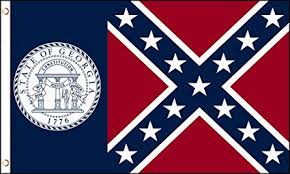Sean Hill at The New England Review:
 And flags change or, rather, are subject to change. As I mentioned before, the Georgia state flag I grew up with featured the Confederate battle flag. We learned the stories behind the Betsy Ross flag with its thirteen stars and the current United States flag and its fifty stars, but how we came to have the state flag I grew up with wasn’t taught in school. Turns out Georgia didn’t have an official flag until 1879. Before that, it had a state seal, which was adopted in 1799, and local militias had to incorporate the coat of arms from the state seal into their hand-sewn banners. That 1879 flag, Georgia’s first official state flag, was modeled on the Stars and Bars, the first national flag of the Confederacy. The Confederacy itself changed its flag several times during the war, and the flag of Robert E. Lee’s army, the Confederate battle flag, was incorporated into subsequent iterations. In 1956 the Georgia General Assembly changed the state flag, replacing the bars on the field with the Confederate battle flag itself. Some lawmakers claimed they wanted to honor Confederate soldiers for the then upcoming centennial of the Civil War. But given that the legislation to change the flag came on the heels of the landmark Brown v. Board of Education decision, placing the Confederate battle flag on the state flag seems to make a pretty clear statement of how those lawmakers and many of their constituency felt about integration. It was an expression of their support of the Confederacy’s white supremacist cause, then in the form of Jim Crow segregation.
And flags change or, rather, are subject to change. As I mentioned before, the Georgia state flag I grew up with featured the Confederate battle flag. We learned the stories behind the Betsy Ross flag with its thirteen stars and the current United States flag and its fifty stars, but how we came to have the state flag I grew up with wasn’t taught in school. Turns out Georgia didn’t have an official flag until 1879. Before that, it had a state seal, which was adopted in 1799, and local militias had to incorporate the coat of arms from the state seal into their hand-sewn banners. That 1879 flag, Georgia’s first official state flag, was modeled on the Stars and Bars, the first national flag of the Confederacy. The Confederacy itself changed its flag several times during the war, and the flag of Robert E. Lee’s army, the Confederate battle flag, was incorporated into subsequent iterations. In 1956 the Georgia General Assembly changed the state flag, replacing the bars on the field with the Confederate battle flag itself. Some lawmakers claimed they wanted to honor Confederate soldiers for the then upcoming centennial of the Civil War. But given that the legislation to change the flag came on the heels of the landmark Brown v. Board of Education decision, placing the Confederate battle flag on the state flag seems to make a pretty clear statement of how those lawmakers and many of their constituency felt about integration. It was an expression of their support of the Confederacy’s white supremacist cause, then in the form of Jim Crow segregation.
more here.
